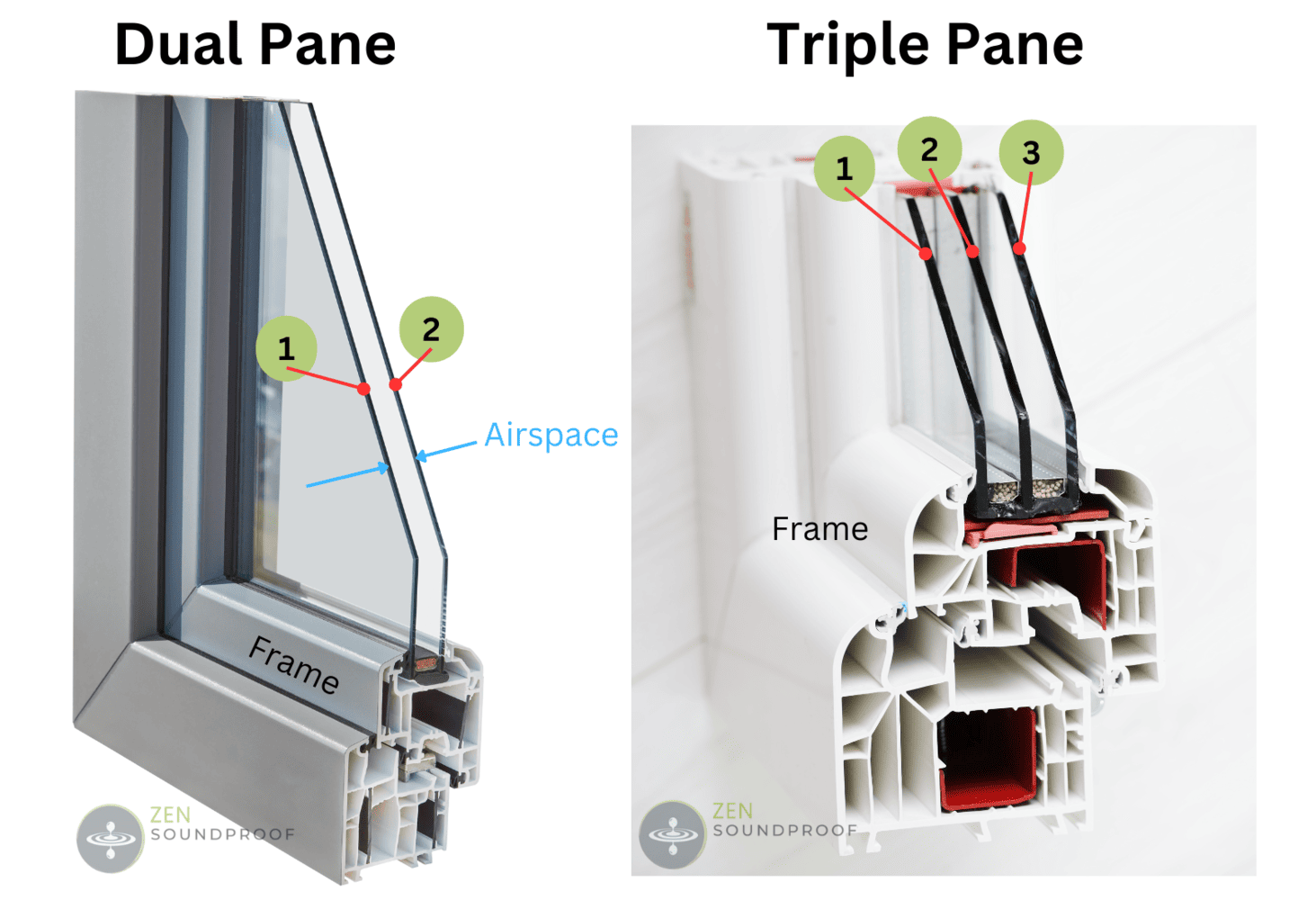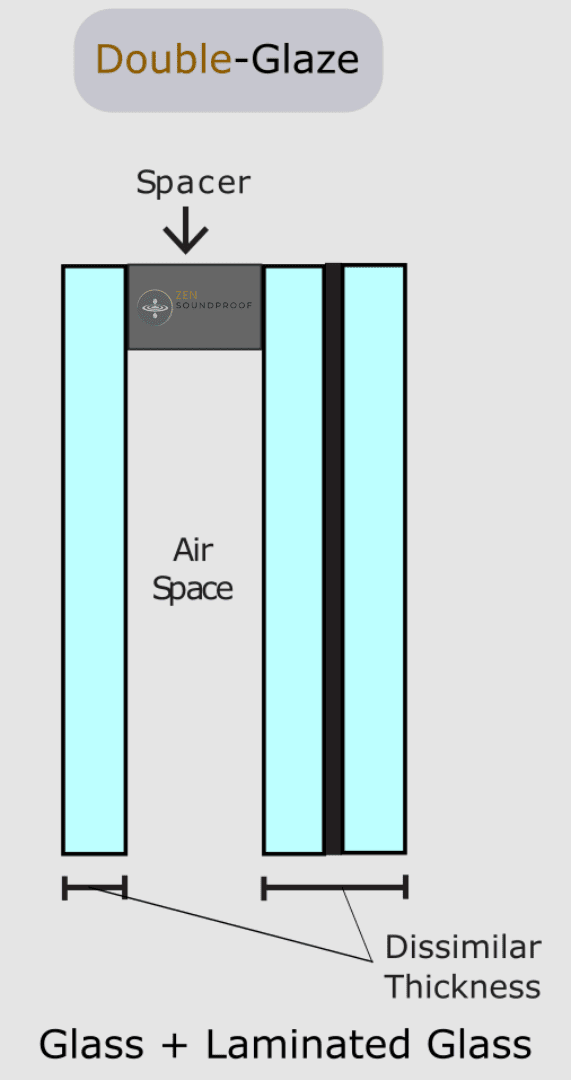In my time working on soundproofing projects, I’ve helped several friends reduce external noise coming into their homes. A major aspect of these projects is finding the best solution for windows because, as you may know, they’re not great at noise reduction.
However, I often come into the project after my friends have done some research. They look at the window options available and tend to ask, do triple pane windows soundproof?
Well, I’d spend a lot of time discussing the pros and cons of triple-glazed windows, so I figured I’d write an article explaining them. Below, I’ll answer the question, do triple pane windows reduce noise?
Let’s begin by understanding what we mean by triple pane and multi-pane windows.
What are Triple Pane Windows?
Triple pane windows are a type of multi-glazed window. As this name suggests, they’re windows that have more than one pane of glass or material. The most common type is double glazing.

A multi-pane window has two or more panes of glass with an air gap in between. The components are as follows:
- Glass. The glass may be normal (float glass), tempered or laminated. Laminated glass has a layer of resin in the middle, which provides a sound-dampening effect.
- Layers/thickness. A multi-pane window will generally have 2 or 3 layers of glass. Most panes of window glass are 3/32” thick but it could be as much as 1/8” thick.
- Air space. This is something of a misnomer, as the gap is usually filled with inert argon gas. Although this is meant for thermal insulation, air gaps help with soundproofing. Air is a poor conductor of sound, so it helps reduce transmission.
- Frames. Window frames are usually wood or UPVC. These materials are better at reducing sound transmission than metal, but the most important component for insulation is the material that holds the glass into the frame. Ideally, it’ll be rubber, as this is great for sound dampening.
Pretty much any multi-pane window will have these elements. While there may be variations in the size of the air gap and composition and thickness of the glass, these are how modern windows are made.
How Do Triple-Glazed Windows Work?
Triple-glazed windows consist of 3 glass panes and 2 air gaps. The supposed benefits are:
Thermal insulation
Having 3 panes and 2 air gaps improves thermal insulation compared to double-glazed windows. We measure thermal insulation using a metric called R-value. Put simply, it measures a material’s ability to resist heat flow.
We also use U-factor, which is essentially the inverse of R-value. It measures heat transfer (both loss and gain). Rather than focusing on a specific material, though, it measures the conduction properties of the various components of the window.
There’s a direct correlation between the number of panes and the R-value and U-factor:
| Number of Panes | R-Value | U-Factor |
|---|---|---|
| Single | 1 | 5 |
| Double | 3.2-3.7 | 3 |
| Triple | 4-7 | 0.8-1.6 |
Higher R-values are better, whereas we want lower U-factor numbers. While the numbers above will vary depending on thickness and glass composition, they’re a good example of the differences between pane numbers.
Acoustic Insulation
Based on Berger’s law, increasing mass should reduce sound transmission. Similarly, decoupling hard layers of glass creates a disrupted transmission path for sound waves. Ideally, each glass pane should also have different thicknesses and mass to help combat different frequencies.
However, stacking several layers of glass isn’t always a good thing because of the triple leaf effect, which I’ll explain below.
Using STC to Measure Triple-Pane Windows
STC stands for sound transmission class. Put simply, it measures a material’s ability to block sound waves from passing through it. A higher number means better sound attenuation, and most building standards aim for 50. For context, a standard, uninsulated wall, made from drywall, has an STC of 33. This equates to normal speech being audible and understandable.
STC is calculated in a lab setting using standardized tests. It uses an average of transmission loss (TL, also known as Rw) across a range of frequencies. This is necessary to understand how materials deal with low frequencies (such as traffic noise) and high frequencies (siren, noise from fans).
Here’s an example of transmission loss recordings for different types of windows. It should show you how they fare against different frequencies.
Improving Window STC for Better Sound Control
Depending on the glass thickness, composition, and number of panes, STC values for windows can range from 25 to 45 or so. Here’s a chart with some examples of STC to illustrate the range:
| Glass Type | Total Thickness (in inches) | Air gap (in inches) | STC |
|---|---|---|---|
| Single-pane | ¼ | N/A | 31 |
| ½ | N/A | 36 | |
| Dual-pane Glass | 1 overall | 1/2 | 35 |
| 1-1/4 overall | 3/4 | 38 | |
| Triple-pane glass | 1-3/4 overall | ½ & ½ | 39 |
| 2-3/4 overall | ¾ & ¾ | 45 | |
| Single-Pane Acoustic Glass (i.e. Laminated Glass) | ¼ overall | N/A | 35 |
| 9/16 overall | N/A | 39 | |
| Dual-Pane Acoustic Glass (One pane is laminated) | 13/16 overall | 3/8 | 37 |
| 1-1/16 overall | 7/16 | 40 | |
| 1-7/16 overall | 3/4 | 44 |
Triple Glazing vs. Laminated Glass
Let’s look at the TL metrics in more detail to understand what they actually mean. The chart uses double and triple pane setups, and double pane acoustic glass. I’ve discussed acoustic glass in a dedicated post, so check that out for more information.

As the graph from the BCIT (British Columbia Institute of Technology) shows, triple glazing has acoustic advantages over double glazing above 160 Hz. However, it has almost identical TL measurements to double pane acoustic, only showing marginal benefits around 200-315 Hz and above 3.15 kHz.

A possible reason for this difference (other than the advantages of a sound-dampening middle layer) is something called the triple leaf effect.
Triple Leaf Effect
In short, the triple leaf effect is a phenomenon where adding mass and layers reaches a critical point where it doesn’t improve (and can even decrease) STC values. In this idea, a leaf is a layer, so a triple leaf setup will be 3 layers and 2 air cavities.
There are a few reasons why the triple leaf effect can happen:
- The air gap will often be smaller, whereas we can usually achieve a larger single air gap in a double leaf setup.
- A single leaf may be thinner in a triple leaf setup, again to save on space.
- A triple leaf construction can impact the resonant frequency, and it can become more complicated or unpredictable than a double leaf setup.
While this logic is mostly applied to drywall setups, it’s also true for glass. The bottom line is that a double-pane setup that includes laminated glass is an optimal combination of mass, thickness, and various materials to achieve a decent STC value for its size.
Pros and Cons of Triple-Glazed Windows
Although it might sound like I’m against triple-glazed windows, there are certainly some advantages. So, here’s a roundup of the pros and cons to help you understand how triple glazing fits into our soundproofing options.
Pros of Triple Glazing
Thermal Insulation
As mentioned, triple-pane windows have higher R-value and U-factor numbers than single and double panes. If thermal insulation and energy efficiency are your main priorities, triple-glazing is the way forward.
Comfort
Triple glazing can also provide superior UV protection, which can be helpful. It can also help cut down on condensation (because of its thermal insulation) and increase energy efficiency. Similarly, the extra layer can cut down on drafts, vastly improving comfort.
Security
Triple glazing is more durable than double glazing and is harder to break. The air gap acts as a shock absorber when hit with blunt force, so 2 air gaps are better than 1! Similarly, 3 panes of glass are harder to get through than 2.
Cons of Triple Glazing
Acoustic Insulation
As we’ve established, triple glazing performs as well as dual-pane laminated glass. There’s therefore no real reason to favor triple glazing for soundproofing alone over more space-efficient methods. For thermal insulation, though, it’s a completely different discussion.
General Glass has produced an exhaustive table comparing all different window setups. As it shows, the best overall performance for a triple-pane window is an STC value of 45. This involves 2 panes of normal glass and a laminated pane for an overall thickness of 2-3/4” (70mm).
In comparison, double pane windows with a laminate layer (normal and laminate) have an STC of 46 with a thickness of 1-15/16” (50mm). While a single STC point might not sound like a lot, you’re saving more than ¾” of space. Put simply, you can have superior noise reduction and a thinner and cheaper window frame.
Weight
Unsurprisingly, an extra glass pane means more weight. In turn, this means thicker frames and potentially extra support to hold everything in place. While this is rare, the surrounding wall will affect this. On the other hand, dual pane laminate should fit into a standard double-glazing frame.
Cost
Again, it should be no surprise that a triple-glazed window is more expensive than double or single pane windows. According to Architectural Digest, the average cost for a triple-glazed window is $1,920. However, a normal double-glazed window is around $900, and acoustic glass can cost around $1,000.
You also need more space to install triple pane windows, simply because the setup is larger than double pane windows. Dual pane windows feature a good compromise between cost, size and performance.
Alternatives to Triple Pane Windows for Soundproofing
So, if triple-glazing isn’t the best solution for soundproofing, what is? Well, the best compromise between cost, construction, and sound reduction is a window insert.
Also known as an interior storm window, it usually consists of a sheet of acrylic or similar. You put it against the window and create an extra air gap in the process. The bigger the gap, the better the performance.
Helpfully, Indow Windows have tested this for us.
According to its research, a window insert on a (non-laminated) double-glazed window drastically improved TL, resulting in an STC increase of 10-14 points.
Unsurprisingly, a window insert had minimal impact on double-pane acoustic glass (increase of 0-1 STC point). This is because it already has a layer of a similar resilient material and has better starting TL values.
So, check out if your glazing is laminated or not before installing a window insert. The last thing you want is to throw money out the window!
Some other options for soundproofing windows on a budget include:
- Acoustic curtains. They provide minor absorption.
- Weatherstripping to help seal gaps.
- Acoustic caulk. Again, to help seal gaps.
- Soundproofing blankets. While they won’t look great, they typically provide more mass than acoustic curtains.
Final Thoughts
I hope this article has clarified the pros and cons and applications of triple glazing. Like any other home renovation project, their use depends on your budget, existing windows, and thermal and acoustic insulation needs.
The bottom line is that triple-glazing provides optimal thermal insulation but lacks on acoustic insulation compared to other setups. If you don’t want to install completely new windows, I recommend building a DIY interior storm window.
Have you replaced your existing windows for better soundproofing? Do you have any experience dealing with triple-glazing? I’d love to hear your thoughts and advice below.
